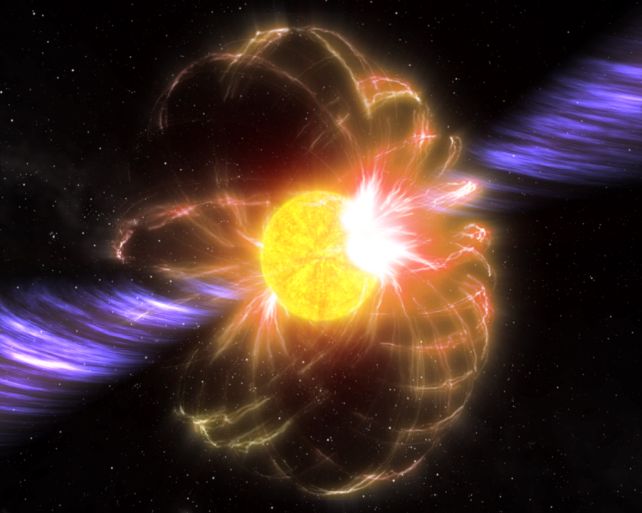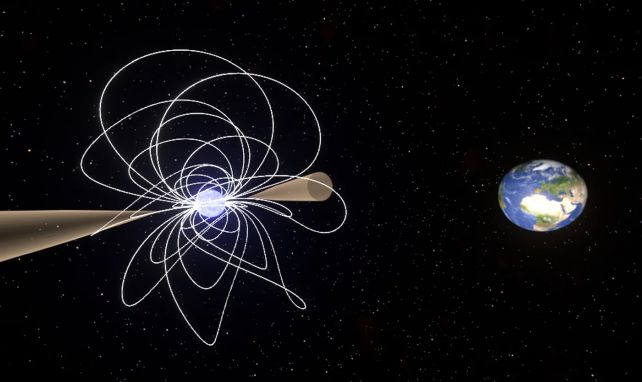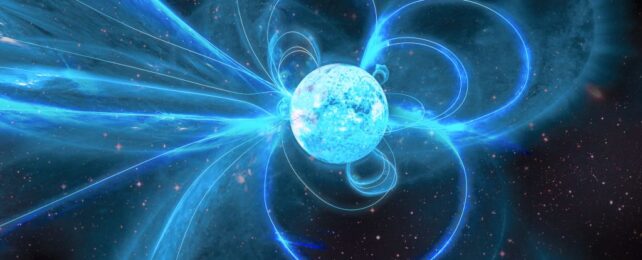One of the weirdest stars in the Milky Way has just gotten even weirder.
It's a magnetar called XTE J1810-197, and it was discovered in 2003 just riotously spitting out radio waves. In 2008, it just… stopped, and pretty much vanished from our view.
Then, in 2018, it roused again. Only this time, there was something odd about the radiation it was emitting.
Now, scientists have analyzed those radio waves in two separate papers, and the results are wack. Those low frequency electromagnetic emissions are twisted in a way we haven't seen before, and the star is appearing to wobble.
"Unlike the radio signals we've seen from other magnetars, this one is emitting enormous amounts of rapidly changing circular polarization," says astrophysicist Marcus Lower of the CSIRO in Australia, who led the first paper. "We had never seen anything like this before."
"We expected to see some variations in the polarization of this magnetar's emission, as we knew this from other magnetars," explains Gregory Desvignes from the Max Planck Institute for Radio Astronomy (MPIfR) in Germany, who led the second paper.
"But we did not expect that these variations are so systematic, following exactly the behavior that would be caused by the wobbling of the star."

All stars are special in their own way, but magnetars are possibly the weirdest of the weird. They're very young neutron stars, which themselves are the collapsed cores of dead massive stars that have gone supernova and ejected most of their material in a colossal explosion. The core that remains collapses under gravity, and it is dense – up to 2.3 times the mass of the Sun, squished into a ball just 20 kilometers (12 miles) across.
Following this collapse process, neutron stars briefly possess an insanely powerful magnetic field. They're basically the most magnetic things in the Universe, with magnetic fields 1,000 times more powerful than a normal neutron star's, and a quadrillion times more powerful than Earth's.
That makes them behave a bit strangely. For example, scientists think that the constant tug-of-war waged between the magnetic field and the gravity of a magnetar causes it to erupt in giant quakes from time to time, sending out blasts of radio waves we call fast radio bursts.
So, just being a magnetar makes XTE J1810-197 an oddball, even without the on-and-off-and-on-again monkeyshines. The recent activity, however, is unprecedented – and could provide new insight into these mysterious stars.
Lower, Desvignes, and their colleagues measured a property of the light emitted by the star known as polarization. That's when the oscillation of the light that reaches us is oriented in a preferred direction. It's normal for magnetar light to be polarized, rotated by the powerful magnetic field it has to pass through to reach us.
Normally, magnetars emit mostly linear polarized light, with a small amount of circularly polarized light traveling in a spiral pattern. XTE J1810-197, Lower and his team found, was emitting huge amounts of circularly polarized light.
Theory suggests that this can happen when the light has to travel through a thick, super-heated 'soup' of particles that can be found in the magnetic field of a neutron star. The behavior of XTE J1810-197 doesn't quite match this prediction, but the researchers have some ideas.
"Our results suggest there is a superheated plasma above the magnetar's magnetic pole, which is acting like a polarizing filter," Lower says. "How exactly the plasma is doing this is still to be determined."

Meanwhile, Desvignes and his team found that the polarization revealed a shift in the magnetar's orientation with respect to Earth. In other words, it seemed to be wobbling, or precessing, like a spinning top. But this got surprising, too: over the next few months, the precession damped significantly, and eventually stopped entirely.
The researchers believe this might be because of a rupture in the surface of the star. This could cause it to temporarily wobble, and also produce super-heated particles in the magnetic field. But if this is the case, and is also normal for magnetars, then it may put paid to the theory that precessing magnetars spew out the rare, repeated fast radio bursts we occasionally detect.
On the other hand, the behavior might reveal something new about some of the most extreme objects in the Universe.
"Damped precession of magnetars might shed light on the inner structure of neutron stars, which is ultimately related to our fundamental understanding of matters," says astrophysicist Lijing Shao of Peking University.
We'll just have to keep watching to see what these wacky dead stars come up with next.
The two papers have been published in Nature Astronomy. They can be found here and here.
